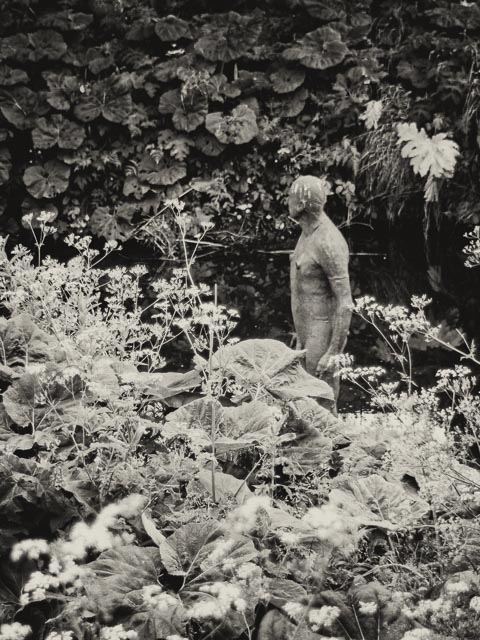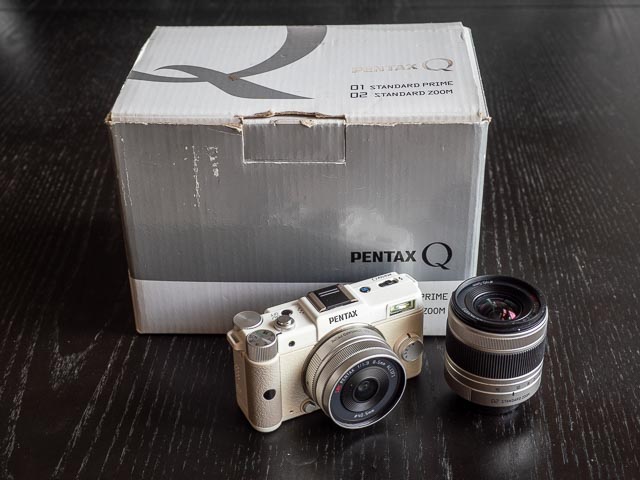Pentax Q
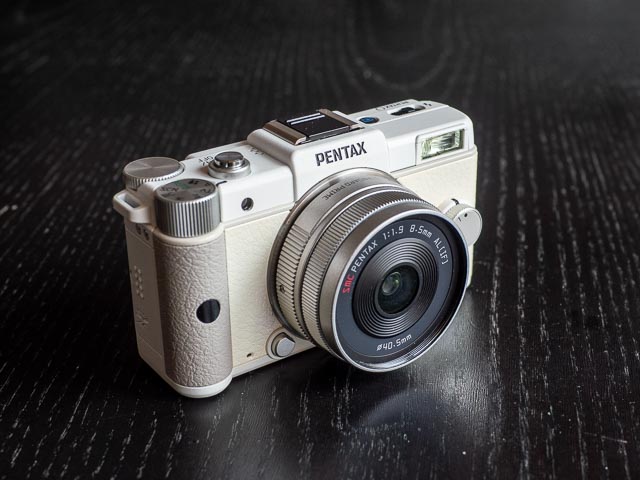
Contents & specification summary
| Launch date | June 2011 |
|---|---|
| Camera type | Mirrorless camera with small sensor |
| Camera size | 180 grams 98 x 57 x 31 mm (inc. battery) |
| Sensor type | CMOS |
| Sensor size | 1/2.3" (6.17 x 4.55 mm) |
| Resolution | 4000 x 3000 (12 megapixels) |
| Memory card | SD/SDHC/SDXC |
| Battery | D-LI68 |
| Lens | Interchangeable - Pentax Q mount |
Introduction
If you were to look at the current range of Pentax cameras you might think the very idea of mirrorless cameras brings Pentax out in hives! The Ricoh Imaging website (the Pentax brand has been part of the Ricoh empire since 2011) talks at some length about how Ricoh believes in the future of SLR photography while mirrorless cameras don't merit a single mention… unless less that is, you delve into the list discontinued products which is, it has to be said, surprisingly extensive, going right back to Pentax's 35mm autofocus cameras of the 1990s and 2000s. Here you'll find information about Pentax's two attempts at cracking the mirrorless camera nut: the K-01 of 2012 (you can also read about the K-o1 on this website) and the Pentax Q series of cameras, including the Q, Q10, Q7 and Q-S1, produced between 2011 and 2017 (although no new Pentax Q cameras were launched after the Q-S1 in 2014).
Given Pentax's dogged determination to carry on as the world's last camera company to provide DSLR fans with new cameras, it should come as no surprise to find out that Pentax's mirrorless cameras were equally dogged in their peculiarity. It was like Pentax was saying OK, if you really, really, really insist we'll have a go at these dratted mirrorless cameras, but we'll be damned if we're going to make the mirrorless cameras you were expecting!
The K-01 used the 16mp ASP-C sensor that was widely lauded by the critics when it appeared in the Pentax K-5 DSLR, but this was combined with divisive "marmite" toy-like styling and the use of the same Pentax K lens mount that Pentax have been using in their SLRs, both film and digital, since 1975. This made the K-01 very bulky next to its competitors. But the Pentax Q was cuter, but even stranger! It introduced a brand new lens mount like most new mirrorless camera systems did, but this was uniquely combined with the type of tiny sensor you'd more typically find in a compact point-and-shoot fixed-lens cameras.
The end result was an adorably tiny interchangeable lens camera, but it was hardly mainstream! But I really don't think that Pentax ever seriously intended the Pentax Q to take over the mirrorless camera world. Instead it wanted to create a deliberately quirky camera that would be adored by a small but loyal band of tiny camera enthusiasts, mainly in Japan. Japan has had a decades long love affair with tiny cameras. For example, 35mm half-frame cameras remained popular in Japan long into the 1980s, despite having fallen out of favour in much of the rest of the world by the middle of the 1970s.
It has to be said that Pentax has form with this sort of camera. In 1978 they launched the impossibly tiny Pentax Auto 110, the world's only full system SLR camera designed for 110 drop in film cartridges that produced 17 x 13mm negatives on 16mm film. Just like the Pentax Q series, it was difficult to really see who would really benefit from using it. 110 film was best suited to ultra-simple point-and-shoot cameras and it simply couldn't produce the sort of results that really justified putting it in a high-quality, technologically advanced (and of course expensive!) camera. But people loved it anyway and it sold surprisingly well, especially in (you guessed it) Japan.
The Pentax Q system
The Pentax Q series of cameras was launched in 2011 and was only officially in production for around 6 years, and with the last new camera launched 2014 it was really only in active development for 4 or 5 years. But in that short time Pentax put together a surpassingly comprehensive system! 4 cameras, 8 lenses and numerous accessories:
Pentax Q series cameras
| Year | Model | Sensor size | Crop factor | Standard colours | Custom colours | Comments |
|---|---|---|---|---|---|---|
| 2011 | Pentax Q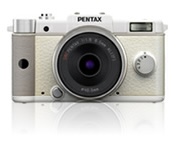 |
1/2.3" (6.17x4.55mm) |
5.6x |
|
n/a | First model in the Pentax Q series with magnesium alloy body |
| 2012 | Pentax Q10 |
1/2.3" (6.17x4.55mm) |
5.6x |
|
100 custom colour combinations | Updated styling and cheaper plastic build quality. |
| 2013 | Pentax Q7 |
1/1.7" (7.44x5.58mm) |
4.65x |
|
120 custom colour combinations | Slightly larger sensor |
| 2014 | Pentax Q-S1 |
1/1.7" (7.44x5.58mm) |
4.65x |
|
40 custom colour combinations | New retro-inspired styling |
Pentax Q mount "High Performance" lenses
Pentax Q mount "High Performance" lenses are designed for normal high quality photography. They all feature auto-focus, variable aperture and mechanical shutter mechanisms and built-in ND filters.
| Model | Focal length | 35mm equiv. on Q/Q10 | 35mm equiv. on Q7/Q-S1 | Max. aperture | Filter thread | Size | Weight |
|---|---|---|---|---|---|---|---|
 01 STANDARD PRIME 01 STANDARD PRIME |
8.5mm | 47.5mm | 39.5mm | f/1.9 | 40.5mm | 45.5 x 23 mm | 37 g |
 02 STANDARD ZOOM 02 STANDARD ZOOM |
5-15mm | 28-84mm | 23-70mm | f/2.8-4.5 | 40.5mm | 48.5 x 48 mm | 96 g |
 06 TELEPHOTO ZOOM 06 TELEPHOTO ZOOM |
15-45mm | 84-252mm | 70-210mm | f/2.8 | 40.5mm | 50 x 56 mm | 90 g |
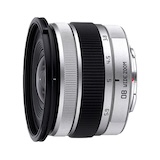 08 WIDE ZOOM 08 WIDE ZOOM |
3.8-5.9mm | 21-33mm | 17.5-27.5mm | f/3.7-4 | 49mm | 54 x 38 mm | 75 g |
Pentax Q mount "Unique" lenses
Pentax Q mount "Unique" lenses are design for fun special effects and toy camera style photography. They all feature manual or fixed focus, fixed apertures and no mechanical shutter mechanism (the camer will go into electronica shutter mode). None of the "Unique" lenses have filter threads.
| Model | Focal length | 35mm equiv. on Q/Q10 | 35mm equiv. on Q7/Q-S1 | Aperture | Focus | Size | Weight |
|---|---|---|---|---|---|---|---|
 03 FISH-EYE 03 FISH-EYE |
3.2mm | 18mm | 16.5mm | f/3.2 | Fixed | 40.6 x 30.5 mm | 29 g |
 04 TOY LENS WIDE 04 TOY LENS WIDE |
6.3mm | 35mm | 29mm | f/7.1 | Manual | 40.6 x 25.0 mm | 21 g |
 05 TOY LENS TELEPHOTO 05 TOY LENS TELEPHOTO |
18mm | 101mm | 84mm | f/8 | Manual | 40.6 x 19.5 mm | 18 g |
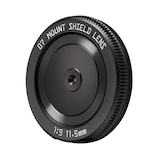 07 MOUNT SHIELD LENS 07 MOUNT SHIELD LENS |
11.5mm | 64mm | 53.5mm | f/9 | Fixed | 40.8 x 6.9 mm | 8 g |
Pentax Q accessories
Some accessories from Pentax's normal DSLRs work with the Pentax Q cameras, for example flash units and remote shutter releases. Pentax also made a wide range of accessories made specially for the Pentax Q system, including an optical viewfinder for the 01 STANDARD PRIME, and special adapter for Pentax K mount lenses, and a variety of lens hoods, filters and cases/bags. See the Ricoh website for more information on Pentax Q accessories.
+ Pentax Q specification
This is the specification for the original Pentax Q model, which is the model I own.
Model Description
| Type | Lens-interchangeable SL digital-still camera |
|---|---|
| Lens Mount | PENTAX bayonet Q-mount |
| Compatible Lens | Q-mount lenses |
Image Capture Unit
| Image Sensor | Type: CMOS sensor with a primary color filter, Size: 1/2.3-inch |
|---|---|
| Effective Pixels | Approx. 12.4 megapixels |
| Total Pixels | Approx. 12.75 megapixels |
| Dust Removal | Image sensor cleaning using ultrasonic vibrations "DR II" |
| Sensitivity (Standard Output) |
AUTO: ISO 125 to 6400 (1/3 EV steps) Bulb mode: up to ISO 1600 |
| Image Stabilizer | Sensor shift Shake Reduction |
File Formats
| File Format | RAW (DNG), JPEG (Exif 2.3), DCF2.0 compliant |
|---|---|
| Recorded Pixels |
|
| Quality Level | RAW (12bit): DNG JPEG: (Best), (Better), (Good) RAW and JPEG simultaneously recordable |
| Color Space | sRGB, AdobeRGB |
| Storage Medium | SD, SDHC, and SDXC Memory Card |
| Storage Folder | Date (100_1018, 100_1019...)/PENTX (100PENTX, 101PENTX...) |
LCD Monitor
| Type | TFT color LCD monitor, wide angle viewing |
|---|---|
| Size | 3.0 inches |
| Dots | Approx. 460,000 dots |
| Adjustment | Brightness and colors adjustable |
| Display | Field of View: approx. 100%, Grid display (4x4 Grid, Golden Section, Scale display), Bright/dark area warning, Histogram |
White Balance
| Auto | TTL by CMOS image sensor |
|---|---|
| Preset | Daylight, Shade, Cloudy, Fluorescent Light (D:Daylight Color, N:Daylight White, W:Cool White, L:Warm White), Tungsten, Flash, CTE, Manual |
| Manual | Configuration on monitor |
| Fine Adjustment | Adjustable ±7 steps on A-B axis or G-M axis |
Autofocus System
| Type | Contrast detection AF |
|---|---|
| Brightness Range | EV1 to 18(ISO125) |
| Focus Method | AF/MF switching |
| Autofocus Method | Face Detection, Tracking, AF Select (25 Points), Select, Spot |
| AF Assist Light | Dedicated LED AF assist light |
| MF Assist | OFF/×2/×4 |
Metering
| Type | TTL image sensor metering, segment metering, centerweighted metering, and spot metering |
|---|---|
| Exposure Compensation |
EV1.3 - 17 (ISO 125, F1.9 lens), +2EV using the Electronic Shutter setting or using the ND filter |
| Exposure Modes |
|
| EV Compensation | ± 3EV (1/3EV step) |
| AE Lock | Can be assigned to the green/delete button from the menu. Continuous as long as the shutter release button is pressed halfway. |
| Shutter | Lens shutter: 1/2000 - 30 seconds (1/3EV step, 1/8000 - 30 seconds when Electronic Shutter setting is enabled), Bulb *Shooting at 1/8000 - 2 seconds with Electronic Shutter and Bulb shooting are not available when using a lens that has no lens shutter. |
| Aperture | From wide open to F8 *Not available when using a lens that has no lens shutter. |
| ND Filter | Off/On *Not available when using a lens that has no lens shutter. |
Drive Modes
| Mode Selection | Single frame, Continuous (Hi, Lo), Self-timer (12s, 2s), Remote Control (0 sec., 3 sec., continuous), Auto Bracketing (3 frames, remote control) |
|---|---|
| Continuous Shooting | Approx. 5 fps, JPEG (12M / Continuous Hi): up to 5 frames, Approx. 1.5 fps, JPEG (12M / Continuous Lo): up to 100 frames |
Built-in Flash
| Built-in Flash | Built-in retractable P-TTL flash Guide number: approx. 5.6 (ISO125/m) / approx. 7 (ISO200/m) Angle of view: coverage: wide angle-lens, equivalent to 28mm in 35mm format |
|---|---|
| Flash Modes | P-TTL, Red-eye Reduction, Slow-speed Sync, Trailing Curtain Sync |
| Sync Speed | Lens shutter: 1/2000 seconds, Electronic shutter: 1/13 seconds |
| Flash Exposure Compensation |
–2.0 to +1.0 EV |
Capture Functions
| Custom Image | Bright, Natural, Portrait, Landscape, Vibrant, Radiant, Muted, Bleach Bypass, Reversal Film, Monochrome, Cross Processing |
|---|---|
| Noise Reduction | High-ISO NR |
| Dynamic Range Setting | Highlight Correction, Shadow Correction |
| Lens Correction | Distortion Correction |
| Digital Filter | Toy Camera, High Contrast, Shading, Slim, HDR, Invert Color, Extract Color, Color, Water Color, Posterization, Fish-eye |
| HDR Capture | Auto, HDR 1, HDR 2 |
| Multi-exposure | Number of shots: 2-9, Exposure adjusted automatically. |
| Interval Shooting | Shooting interval: 1 sec. to 24 hr., Start Interval setting: immediately from the set time, Number of shots: up to 999 images |
| Smart Effect | Brilliant Color, Unicolor Bold, Vintage Color, Cross Processing, Warm Fade, Tone Expansion, Bold Monochrome, Water Color, Vibrant Color Enhance, USER 1 to 3 |
Movie
| File Format | MPEG–4 AVC/H.264 |
|---|---|
| Recorded Pixels | Full HD (1920x1080, 16:9, 30fps), HD (1280x720, 16:9, 30fps), VGA (640x480, 4:3, 30fps) |
| Sound | Built-in monaural microphone |
| Recording Time | Up to 25 minutes; automatically stops recording if the internal temperature of the camera becomes high. |
| Custom Image | Bright, Natural, Portrait, Landscape, Vibrant, Radiant, Muted, Bleach Bypass, Reversal Film, Monochrome, Cross Processing |
| Digital Filter | Toy Camera, High Contrast, Shading, Slim, HDR, Invert Color, Extract Color, Color, Water Color, Posterization, Fish-eye |
| Interval Movie | Recording interval: 1 sec., 5 sec., 10 sec., 30 sec., 1 min., 5 min., 10 min., 30 min., 1 hr., Recording time: 5 sec. to 99 hr. Start Interval setting: immediately, from the set time |
Playback Functions
| Playback View | Single frame, image comparison, multi-image display (4, 9, 20, 42, 90 segmentation), display magnification (up to 16x, scrolling and quick magnification available), rotating, histogram (Y histogram, RGB histogram), bright/dark area warning, detailed information display, folder display, calendar display, slideshow |
|---|---|
| Delete | Delete single image, delete all images, select & delete, delete folder, delete instant review image |
| Digital Filter | Monochrome, Toy Camera, High Contrast, Shading, Slim, HDR, Invert Color, Extract Color, Color, Water Color, Posterization, Fish-eye, Retro, Soft, Sketch Filter, Miniature, Frame Composite, Starburst, Base Parameter Adjustment |
| RAW Development | File Format (JPEG), Aspect Ratio, Color Space, Custom Image, White Balance, Sensitivity, High-ISO NR, Shadow Correction, Distortion Correction |
| Edit | Resize, Cropping (aspect ratio adjustment available), Index, Movie Editing (divide or delete selected frames), Capturing a JPEG still picture from a movie, Red-eye Edit, Saving buffer as a RAW file |
Customisation
| Custom Functions | 13 items |
|---|---|
| Mode Memory | 12 items |
| Button/ Dial Customization |
Green/Delete button: Green Button, Preview, One Push File Format, AE Lock, Enable AF Quick Dial: Smart Effect, Custom Image, Digital Filter, Aspect Ratio |
| World Time | World Time settings for 75 cities (28 time zones) |
| Language | English, French, German, Spanish, Portuguese, Italian, Dutch, Danish, Swedish, Finnish, Polish, Czech, Hungarian, Turkish, Greek, Russian, Korean, Traditional Chinese, Simplified Chinese, and Japanese |
Power Supply
| Battery Type | Rechargeable Lithium-ion Battery D-LI68 |
|---|---|
| AC Adapter | AC Adapter Kit K-AC115 (optional) |
| Battery Life |
Number of recordable images: approx. 230 images (with 50% flash usage), approx. 250 images (without flash usage) Playback time: approx. 160 minutes * Using a new lithium-ion battery under the temperature at 23 ºC, Tested in compliance with CIPA standard. Actual results may vary depending on the shooting conditions/circumstances. |
Interfaces
| Connection Port | USB 2.0 (high-speed compatible) / AV output terminal, HDMI output terminal (Type D) |
|---|---|
| USB Connection | MSC/PTP |
| Video Output Format | NTSC/PAL |
Dimensions and Weight
| Dimensions | Approx. 98.0mm (W) x 57.5mm (H) x 31.0mm (D) (excluding the operation parts and protrusion) |
|---|---|
| Weight |
Approx. 200g (loaded and ready with the dedicated battery and SD Memory Card), Approx. 180 g (body only) |
Accessories
| Package Contents |
USB Cable I-USB7, Strap O-ST115, Rechargeable Lithium-ion Battery D-LI68, Battery Charger D-BC68P, Software (CDROM) S-SW115 <Mounted on the camera> Hot shoe cover FK, Body mount cover |
|---|---|
| Software | SILKYPIX Developer Studio 3.0 for PENTAX |
Buying a Pentax Q in 2025
OK, so this is where I have some bad news! The whole Pentax Q series of cameras, lenses and accessories has quite become quite a cult classic. This means that buying any of these items puts you in competition with not just with other photographers, but with dedicated and determined collectors who want the full set of 4 cameras (probably with each in several colours!), 8 lenses and as many accessories as possible. So if you want to join the Pentax Q club, be prepared to pay handsomely for the privilege 
Roughly speaking expect to pay some where between £100 and £250 for a camera (with the early Pentax Q and Q10 models being less desirable than the later Pentax Q7 and Q-S1 models with their slightly larger sensors). The 01 STANDARD PRIME, 02 STANDARD ZOOM and 06 TELEPHOTO ZOOM will generally set you back somewhere between £100 and £150. The 08 WIDE ZOOM was introduced late to the Pentax Q system and was always very expensive when new, with the result that it will set you back the proverbial arm & leg today! You will often see £500 or more being asked for it! And some of the accessories can also be very expensive: in particular the O-VF1 optical viewfinder for the 01 STANDARD PRIME is likely to cost £200-250 (yes, twice what you'll pay for the lens itself!) and the official K mount adapter, with it's electronic contacts and built-in aperture and mechanical shutter mechanism will likewise set you back around £250.
The Pentax Q system was always far more popular in Japan that anywhere else in the world, so if you want a rare item like the 08 WIDE ZOOM or a Pentax Q10 or Q7 in some whacky custom colour combination you may well have to personally import from Japan. Just bear in mind when you browsing eBay, that VAT will be charged when you personally import into the UK, even if you're buying from a private seller. (Fortunately, my understanding is that no further import duties are payable when personally importing camera equipment into the UK.)
But, with patience (and a great deal of persistent Googling!), you can find Pentax Q gear at least at semi-reasonable prices. I found a Pentax Q twin lens kit (i.e. with the 01 STANDARD PRIME and 02 STANDARD ZOOM) in white (IMHO a particularly stylish colour!), boxed and in near mint condition on the Cash Converters website for £200 (but I have to admit that my general experience with Cash Converters has been rather mixed!). I subsequently bought the 06 TELEPHOTO ZOOM for a little under £100 on eBay.
Using a Pentax Q in 2025
 The original Pentax Q model immediately impresses with it's high quality magnesium alloy body. The second thing that hits you is the size. No matter how small you were expecting it to be, it still comes as a surprise when you finally see it in the flesh! It's difficult to convey in a photograph just how small it is, but hopefully this photograph of it in my average sized man's hand will give you some idea! But despite it's tiny size, it doesn't really qualify as pocketable. Even with the smallest lens (the 01 STANDARD PRIME) attached, the lens sticks out too far to comfortably put it in a jeans pocket, though it goes into a larger jacket pocket easily enough.
The original Pentax Q model immediately impresses with it's high quality magnesium alloy body. The second thing that hits you is the size. No matter how small you were expecting it to be, it still comes as a surprise when you finally see it in the flesh! It's difficult to convey in a photograph just how small it is, but hopefully this photograph of it in my average sized man's hand will give you some idea! But despite it's tiny size, it doesn't really qualify as pocketable. Even with the smallest lens (the 01 STANDARD PRIME) attached, the lens sticks out too far to comfortably put it in a jeans pocket, though it goes into a larger jacket pocket easily enough.

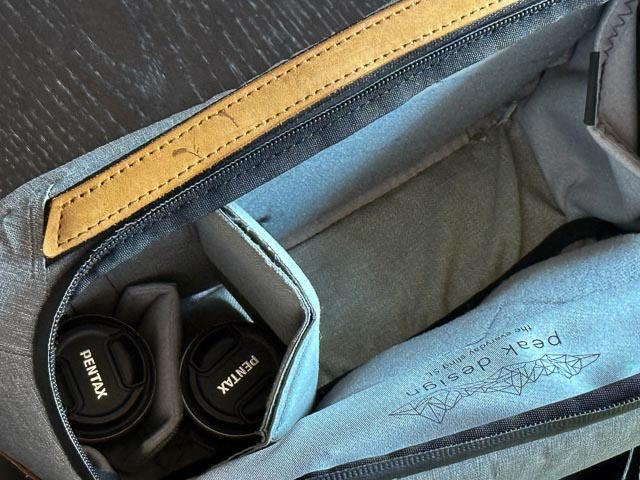 The small size of the Pentax Q perhaps really comes into its own with a small camera bag. This really is the only camera that allows me to fit a complete outfit in my smallest 5 litre Peak Design sling bag, with plenty of space left over for a packed lunch! The Peak Design FlexFold divider, which allows items to be carried on two levels, is key here. On the bottom level I have the 2 zoom lenses (separated by a divider from another bag), while the camera with the 01 STANDARD PRIME attached is on the top level.
The small size of the Pentax Q perhaps really comes into its own with a small camera bag. This really is the only camera that allows me to fit a complete outfit in my smallest 5 litre Peak Design sling bag, with plenty of space left over for a packed lunch! The Peak Design FlexFold divider, which allows items to be carried on two levels, is key here. On the bottom level I have the 2 zoom lenses (separated by a divider from another bag), while the camera with the 01 STANDARD PRIME attached is on the top level.

 Of course the small size also means the controls are tiny too, though even with my chubby fingers I found the camera surprisingly easy and pleasant to operate. The left of the top plate features a lever to raise the built-in flash to an impressive height (though the flash will happily fire in the closed as well as raised positions) and a playback mode button. In the middle you'll find a standard hotshoe that works well with any standard Pentax flash unit. On the right side of the top plate you find the shutter button, on/off button, a familiar 'PASM' mode dial and a particularly well designed command dial right on the corner and perfectly position for the right thumb to operate.
Of course the small size also means the controls are tiny too, though even with my chubby fingers I found the camera surprisingly easy and pleasant to operate. The left of the top plate features a lever to raise the built-in flash to an impressive height (though the flash will happily fire in the closed as well as raised positions) and a playback mode button. In the middle you'll find a standard hotshoe that works well with any standard Pentax flash unit. On the right side of the top plate you find the shutter button, on/off button, a familiar 'PASM' mode dial and a particularly well designed command dial right on the corner and perfectly position for the right thumb to operate.
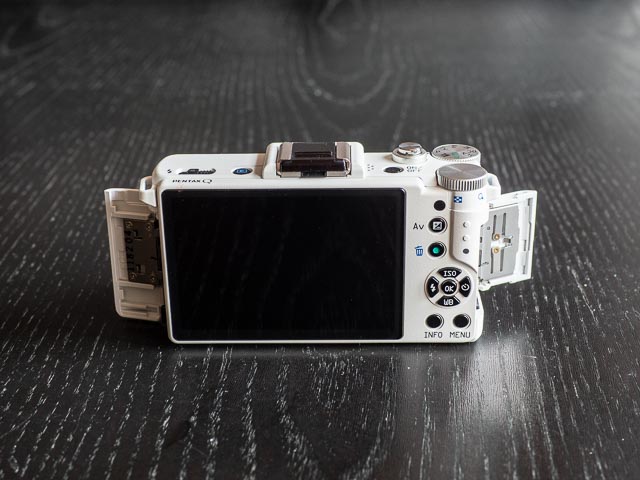 One unusal, but very welcome, design choice for this class of camera is separate compartments for the battery on the left side, and the memory card on the right side. Because these doors are on the sides of the camera there is no chance of a tripod getting in the way of opening them. The style of photography this camera really suits (casual snap-shot photography) means I rarely feel the need to use a tripod. But if you want to use a tripod, the tripod bush is perfectly aligned with the lens.
One unusal, but very welcome, design choice for this class of camera is separate compartments for the battery on the left side, and the memory card on the right side. Because these doors are on the sides of the camera there is no chance of a tripod getting in the way of opening them. The style of photography this camera really suits (casual snap-shot photography) means I rarely feel the need to use a tripod. But if you want to use a tripod, the tripod bush is perfectly aligned with the lens.
So overall, the Pentax Q makes for a very agreeable companion when you want to carry your smallest possible camera bag! But that doesn't mean there aren't any problems with the Pentax Q… The main one being the lack of an eye-level electronic viewfinder. The rear monitor is fairly large and sharp, and like I've said before on these pages, I actually quite like composing a photograph on a flat screen that comes close to viewing a real (if small) photographic print. But even a modest amount of sunlight renders makes framing your images a matter of partial guess work, and confident manual focussing completely out of the question. Also, the tiny postage-stamp sized battery doesn't last very long. You'll want at least one spare at the very least for all day photography.
Pentax Q results
 What you think of the results from the Pentax Q will depend a lot on what you think its natural competitors are. A lot of the contemporary reviews of this camera took the approach that because it has interchangeable lenses, it should be compared to other cameras with interchangeable lenses, which generally use four thirds or APS-C sensors. In such comparisons the Pentax Q does not do well! You will see all the problems that other small sensor cameras tend to exhibit: relatively low detail resolution, poor high ISO performance, chromatic aberrations and poor dynamic range. Such comparisons can make it really difficult to understand the point of such a camera! It just comes across as a small but decidedly inferior mirrorless camera.
What you think of the results from the Pentax Q will depend a lot on what you think its natural competitors are. A lot of the contemporary reviews of this camera took the approach that because it has interchangeable lenses, it should be compared to other cameras with interchangeable lenses, which generally use four thirds or APS-C sensors. In such comparisons the Pentax Q does not do well! You will see all the problems that other small sensor cameras tend to exhibit: relatively low detail resolution, poor high ISO performance, chromatic aberrations and poor dynamic range. Such comparisons can make it really difficult to understand the point of such a camera! It just comes across as a small but decidedly inferior mirrorless camera.
But treat the Pentax Q as a compact digicam that just happens to have the considerable creative boost of interchangeable lenses, and things start to make a lot more sense! Suddenly you have a camera that does rather well in terms of image quality compared to it's natural digicam competitors. Of course typical compact digicams with their collapsable zoom lenses will be much more pocketable than the Pentax Q. But the Pentax Q counters with the creativity that comes with interchangeable lenses. Plus, if you just happen to like the creative discipline that comes from shooting with a single, fixed-focal length lens, then the Pentax Q is pretty much you're only genuinely compact option that give that option with a 50mm equiv. lens. Other compact cameras with prime lenses tend to have a focal length around 28mm. So with all that said, let's have a look at some results:
 Pentax 01 STANDARD PRIME
Pentax 01 STANDARD PRIME
Let's start off with my (and, it seems, everyone else's!) favourite Pentax Q lens. On the Pentax Q it give a field of view similar to a 50mm standard lens on a 35mm full-frame camera. And at just 37 grams if keeps the Pentax Q at it's smallest. The fast maximum aperture of f/1.9 means that you can get modest but satisfying amounts of bokeh, at least for close up photography.

f/1.9 - 1/800 - ISO250

f/3.2 - 1/800 - ISO125
With a 35mm equiv. maximum reproduction ratio of a little over quarter life-size you can get surprisingly effective close-up shots with the 01 STANDARD PRIME (and the other lenses give similar reproduction ratios).
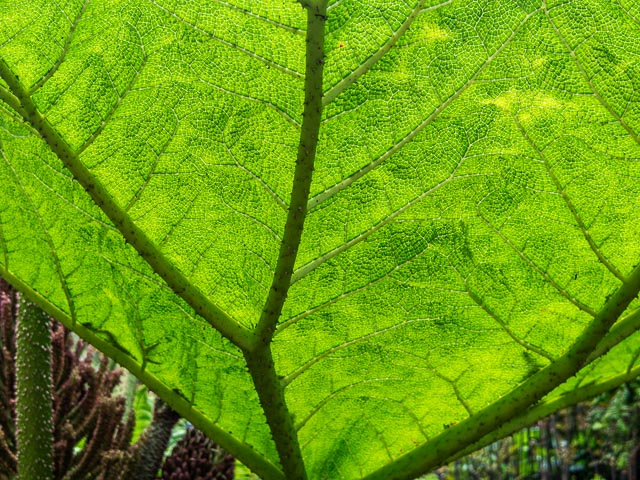
f/3.2 - 1/250 - ISO125
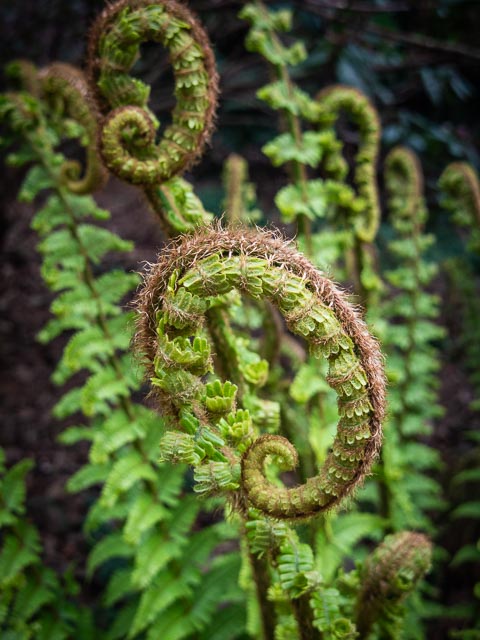
f/3.2 - 1/250 - ISO125

f/8.0 - 1/15 - ISO125
Getting a little bit creative with a long shutter speed and some intentional camera movement. I used the 01 STANDARD PRIME's built-in ND filter to get a long shutter speed.
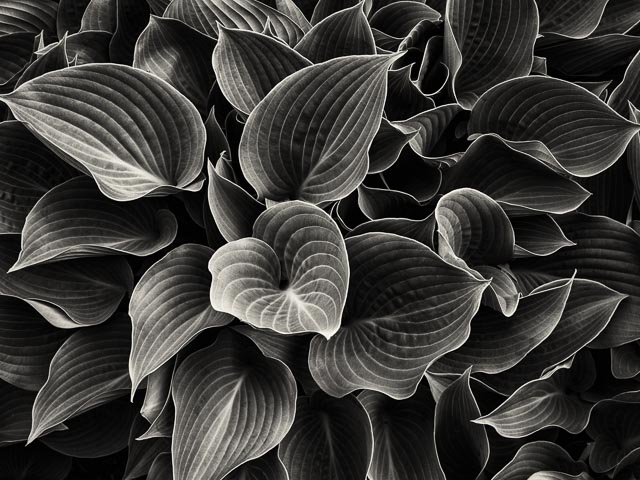
f/3.2 - 1/500 - ISO200
The Pentax Q files responded quite well to b&w conversion in Silver Efex Pro.
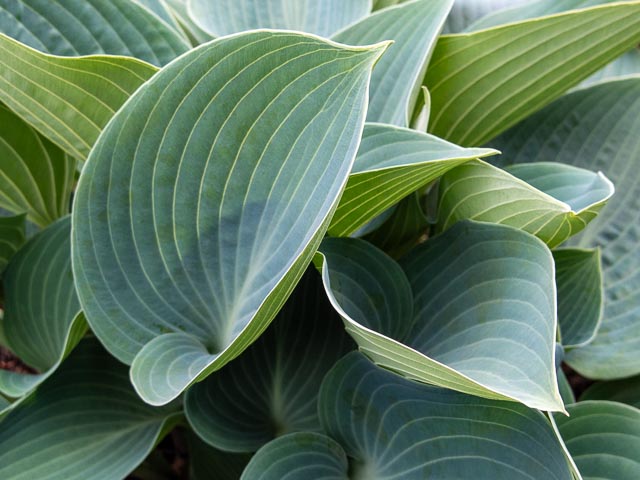
f/3.2 - 1/400 - ISO125

f/1.9 - 1/320 - ISO125

f/1.9 - 1/800 - ISO125

f/1.9 - 1/800 - ISO125
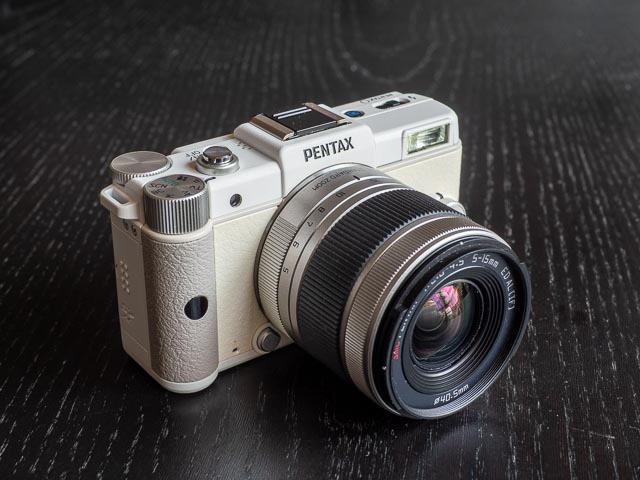 Pentax 02 STANDARD ZOOM
Pentax 02 STANDARD ZOOM
Next comes what is probably the most common Pentax Q lens, the 02 STANDARD ZOOM. On the Pentax Q it give a field of view similar to a 28-85mm standard zoom lens on a 35mm full-frame camera.

14.5mm - f/5.0 - 1/250 - ISO125
This shot illustrates the rather weird nature of the dynamic range problems the Pentax Q sometimes exhibits. Note the strange blown highlights on the leaf stems (circled in green). I'm not sure I've ever seen anything quite like this before!

14.5mm - f/5.0 - 1/250 - ISO125
On this version of the same shot I've cloned out the blown highlights in Lightroom. Fortunately this was pretty quick to do.

5mm - f/2.8 - 1/60 - ISO250

5mm - f/4.0 - 1/200 - ISO125

 Pentax 06 TELEPHOTO ZOOM
Pentax 06 TELEPHOTO ZOOM
Finally, here are some shots from the 06 TELEPHOTO ZOOM. Uniquely among the Pentax Q lenses, this one is collapsable for transportation. Here you can see the lens both collapsed and extended. This lens does not change size when zoomed or focussed.

15mm - f/2.8 - 1/200 - ISO125

20.2mm - f/2.8 - 1/125 - ISO400

27mm - f/2.8 - 1/160 - ISO400

31.5mm - f/3.2 - 1/400 - ISO125

20.2mm - f/2.8 - 1/125 - ISO200

44.7mm - f/3.5 - 1/500 - ISO125
 Adapted 8mm cine camera lenses
Adapted 8mm cine camera lenses
Like any other mirrorless camera, you can adapt vintage lenses to your Pentax Q camera. Because the sensor in the Pentax Q is so much smaller than a 35mm camera, adapting 35mm lenses is going to turn any lens you try into a super telephoto lens! But that small sensor also opens up the possibility of adapting lenses that have imaging circles far too small to adapt to any other mirrorless camera, for example, lenses from 8mm cine cameras. Just bear in mind that the frame size for the Standard 8 cine format is 4.8×3.5mm, and for the Super 8 format it's 5.8x4mm, both of which are smaller than the 6.17x4.55mm sensor in the Pentax Q, so don't necessarily expect 8mm cine lenses to fully cover the Pentax Q sensor. I got by far the best results from a Cine Yashinon 38mm f/1.4 lens (the lens to the right of those pictured here). All these shots are from this lens wide open at f/1.4. As you can see this lens provides an opportunity to get genuinely shallow depth-of-field even with the tiny sensor in the Pentax Q! There is a full report on my experiences using these D mount cine lenses on Pentax Q in the Outlandish lenses section of this website.


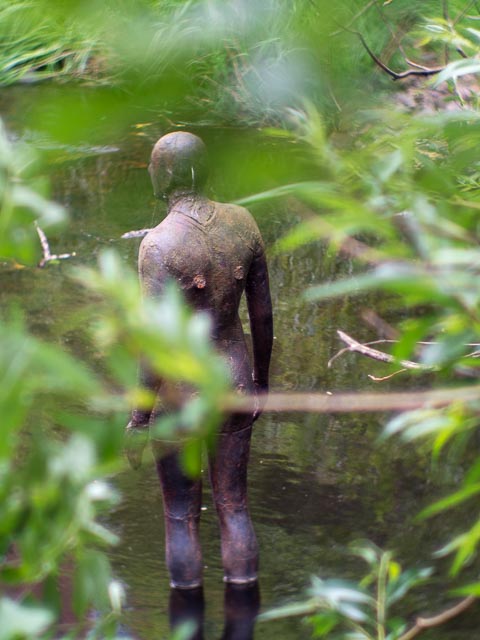

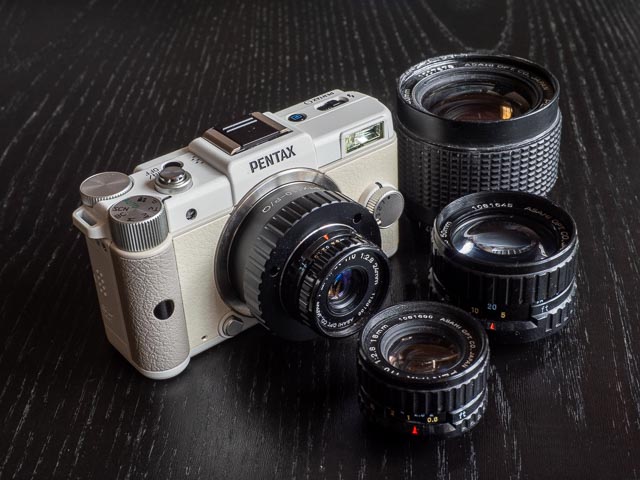 Adapted Pentax-110 lenses
Adapted Pentax-110 lenses
Given the conceptual similarity of the Pentax Auto 110 film SLR camera to the Pentax Q, it's natural to want to adapt the lenses from that camera. But of course 110 negative are approximately 8 times the size of the Pentax Q sensor, so adapting them to the Pentax Q drastically change their scope of use. For example, the 24mm standard lens (equivalent to a 50mm lens on a 35mm camera) from the Pentax Auto 110 becomes a tiny 135mm equiv. telephoto lens on the Pentax Q. That 24mm standard lens is also notable for a distinct soap bubble effect when you have specular highlights in the background. I found focusing these lenses on the Pentax Q was a major challenge, but when you do just happened to nail the focus (probably more by luck than judgement!) there is a surprising amount of details in these images. There is a full report on my experiences using these Pentax-110 lenses on Pentax Q in the Outlandish lenses section of this website.


